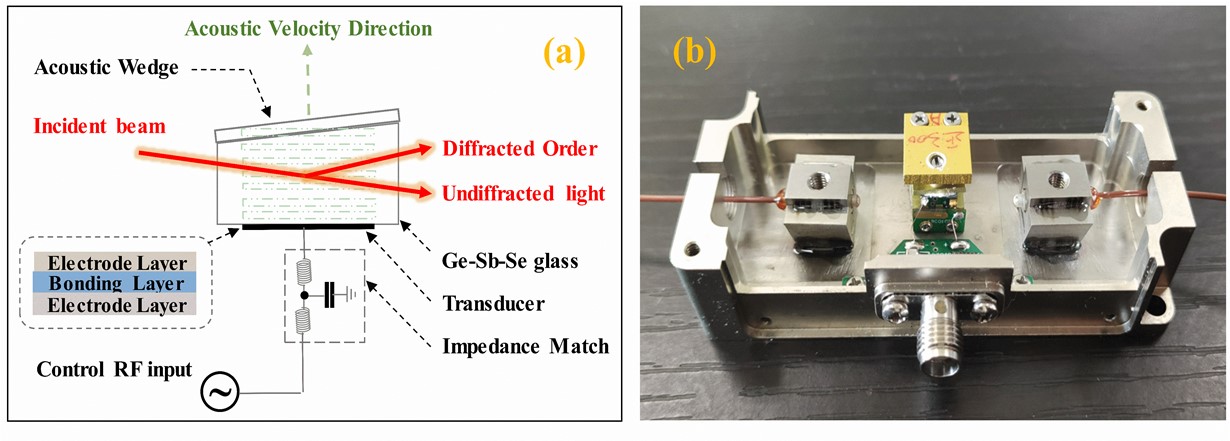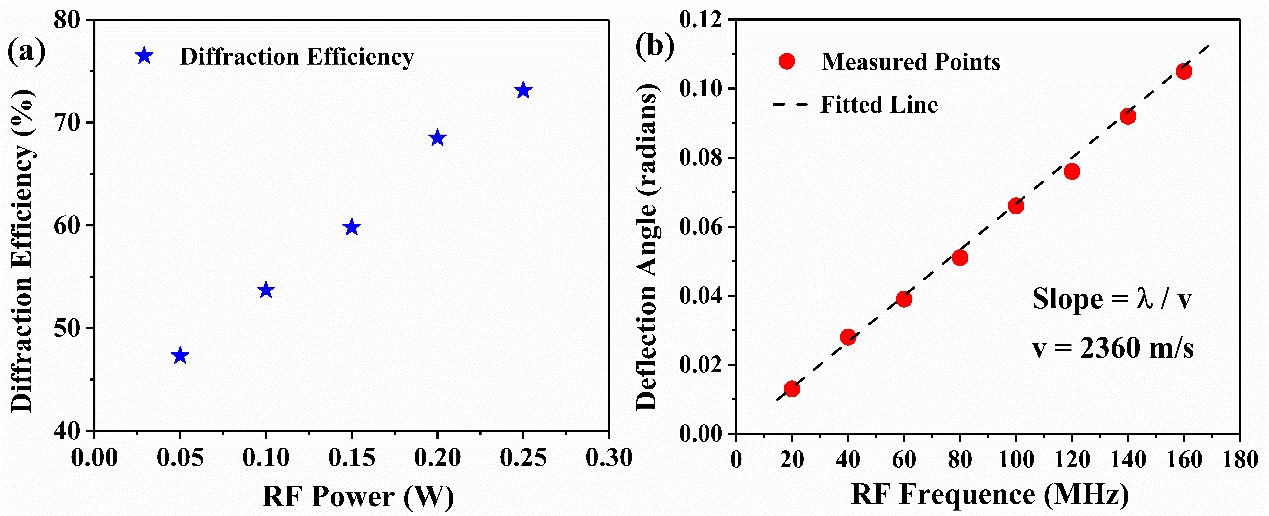Recently, Shengjie Ding (first author), a postgraduate student in our laboratory, and professor Shixun Dai (corresponding author) have published an article entitled “High-performance acousto-optic modulator based on environmentally favorable Ge20Sb15Se65 chalcogenide glass” in Ceramics International (Ceramics International. 2021, 47 (21), 30343-30348. https://doi.org/10.1016/j.ceramint.2021.07.214).
For decades, the light modulation technology with laser as the carrier has been studied extensively. Among these technologies, the AO modulation technology has been widely used in signal processing fields, such as industry and agriculture due to its simple structure and good modulation effect. As one of the typical acousto-optic (AO) materials, chalcogenide glass has great advantage in the preparation of AO devices due to its high AO figure of merit (M2), ultra-wide transmission window, excellent thermodynamic stability, isotropy, easy processing and low price. However, typical chalcogenide glasses, such as As2S3 and As2Se3, have been reported to be suitable for manufacturing AO modulators in the visible and near-IR regions but have relatively low glass transition temperature (Tg) of about 185 °C and 178 °C, respectively, thereby limiting their use as commercially available AO devices. Although Ga–La–S chalcogenide glass with a highTg of 561 °C, the relatively small refractive index and high acoustic velocity lead to its low M2 of 19 ´ 10−15 s3/kg, which ultimately resulted in the AOM prepared by this glass only achieved a diffraction efficiency of about 40% at 1.2 W RF power. Still, the AMTIR-1 (Ge33As12Se55) chalcogenide glass now produced by the American Amorphous Materials Inc. has been demonstrated to have excellent AO performance, and the high efficiency AO devices prepared by IntraAction Corp. using this component has been commercialized. However, like promising AO chalcogenide glasses As2S3 and As2Se3, this composition is based on the Arsenic (As), which is toxic element. Therefore, safety problems may occur in the process of glass preparation, processing, and performance testing. In particular, the toxic materials may be vaporized when they are applied to high laser power, and these vaporized gases are extremely harmful to health. In comparison, the environmentally favorable family of Ge–Sb–Se chalcogenide glasses are more attractive to be used as AO medium due to the replacement of highly toxic As with antimony (Sb). This glass system possesses the aforementioned advantages of chalcogenide glasses, and presents broad application prospects in the fields of modern integrated optoelectronics, such as infrared sensing, infrared imaging, energy transmission, and nonlinear optics. Nevertheless, the investigation of Ge–Sb–Se materials on AO properties are still lacking. In this article, a typical glass composition of Ge20Sb15Se65 frequently used in waveguides and fiber-based optical designs was proposed for AOM manufacturing. The structure characteristics, thermomechanical, optical, and AO properties of this glass were also measured, and the results show that Ge20Sb15Se65 glass possesses excellent performance of wide transmission in the infrared region spectral, high glass transition temperature and strong mechanical strength. Particularly, its outstanding AO figure of merit (M2 = 407´10−15 s3/kg) was approximately 270 times that of fused quartz glass, making it attractive for AO device designs. In the end, the fabricated AOM using Ge20Sb15Se65 glass as AO material was introduced, and we obtained a high diffraction efficiency of 73.4% at a high acoustic frequency of 160 MHz and an extremely low radio-frequency (RF) power of 0.25 W when the laser beam at 1550 nm was controlled. To our best knowledge, the results of initial tests on the AOM prepared from Ge–Sb–Se chalcogenide glass were first reported. Such an AOM design fills the gap in the application of Ge–Sb–Se chalcogenide glass in AO devices, and provides valuable considerations for better matching in future commercial AO applications.

Fig. 1. (a) AO Cell Schematic and (b) Product Photo Show.

Fig. 2. (a) Variation of the diffraction efficiency with the RF power and (b) variation of the deflection angle with the RF frequency.


